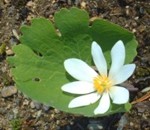I ran across information about bloodroot several times. I was curious enough to look deeper. I was impressed by the testimonials and pictures that I saw. I also noticed that there were plenty of websites that tried to dissuade people from using bloodroot by posting the one “scary” picture of bloodroot treatment at its “worst.” Once I read that it was a remedy used by Native Americans, I was pretty much convinced it was something that I wanted to research and try.

From Zenith Herbal
https://www.zenithherbal.com/what-is-bloodroot-and-bloodroot-salve/
What is Bloodroot and Bloodroot Salve?
Bloodroot is a flowering herb widely used by Native Americans both as a dye and as a medicine. This plant is native to the United States and Canada. When the Bloodroot plant is cut, the budding rootstalk and root release a blood red fluid that gives it its names. Herbalists harvest this plant during the fall as it is the best time to make medicines out of it.
Medical History of Bloodroot
Native Americans created medicines from Bloodroot for the following ailments:
- Colds
- Congestion
- Diphtheria
- Hemorrhagic Tuberculosis
- Abdominal Cramps
- Vomiting
- Gastrointestinal Hemorrhages and Abdominal Lumps
- Open wound
- Gangrenes
As modern medicine improves, the use of bloodroot for medicinal purposes started to diminish. Here are some Early Western accounts of the medicinal power of bloodroot:
From interaction with Native Americans, European Colonists were able to utilize Bloodroot medicinal properties to cure western ailments. The rhizome or rootstalk proved to be an important part of the flowering plant and that is not the only part of the plant that proved to be effective. In addition, they were able to create medicinal products that cure tremors, headaches, asthma, and more when bloodroot was used together with its leaves and roots. Further studies during this time showed Europeans that Bloodroot also has anti-inflammatory properties.
Bloodroot as a cure for cancer has been proven historically.
In the mid-1800s, a doctor in London developed a treatment using a combination of a Bloodroot paste, flour, water, and zinc chloride. He used this concoction to apply directly to breast tumors and other cancers. Another account of using Bloodroot is an American Surgeon named Jesse Weldon Fell. He learned to create a medicinal mixture from Cherokee Indians to treat cancer and he also verified that pairing bloodroot with Zinc Chloride enhances the plants cancer-curing properties. With this knowledge came the Bloodroot product known as Black Salve.
Wikipedia says:
Sanguinaria canadensis, bloodroot, is a perennial, herbaceous flowering plant native to eastern North America. It is the only species in the genus Sanguinaria, included in the family Papaveraceae, and most closely related to Eomecon of eastern Asia. Products made from sanguinaria extracts, such as black salve, are escharotic and can cause permanent damage. Claims that it can treat cancer and other illness have little support.
PubMed:
But, here is a link that talks about sanguinaria and cancer that says:
“sanguinarine possesses strong antiproliferative and proapoptotic properties”
https://pubmed.ncbi.nlm.nih.gov/15299076/
Another link says, “In this study, we investigated the underling mechanisms by which sanguinarine induce apoptosis in human breast cancer MDA-231 cells. Treatment of MDA-231 cells with sanguinarine induced remarkable apoptosis.” https://pubmed.ncbi.nlm.nih.gov/18189268/
Other Websites:
https://www.healthbenefitstimes.com/bloodroot/
https://www.cancerplants.com/cancer-plants/bloodroot/
https://www.altmedicine101.com/bloodroot-evidence-based-benefits-and-uses
Do your own research. Consult your gut instinct. And proceed carefully.
